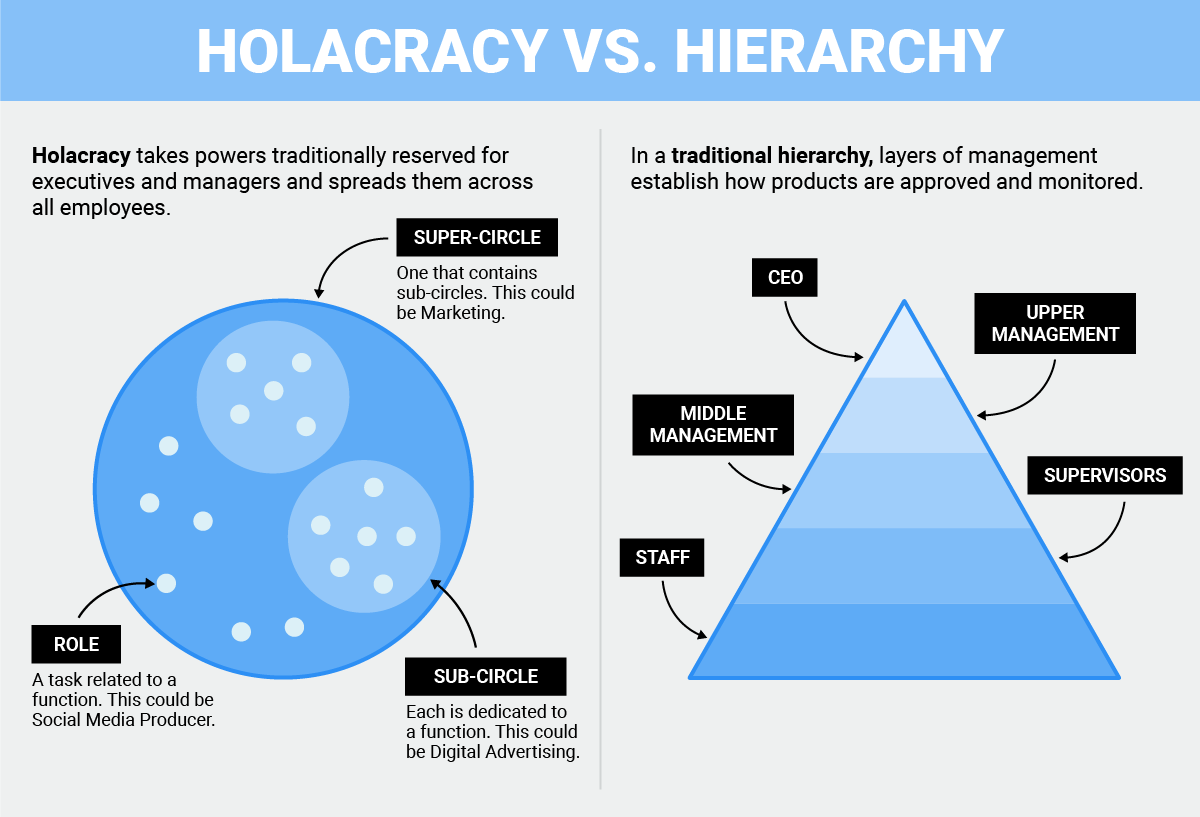Table of contents
The decision of U.S. multinational footwear distributor Zappos to abolish its pyramidal structure in 2013 and establish a new system “without bosses or flowcharts” caused a stir in top media companies and in the management sector, introducing a concept to c-suites and top business schools that was hitherto unknown: holacracy.
While this corporate organizational system emerged in 2007 at the hands of Ternary Software (USA), it took its adoption by a company of more than 1,600 employees and a turnover of over $1,000 million before holacracy truly shot to fame.
Although feelings aroused by this new management style are often polarized (it is alternately praised as a new trend that only the most cutting edge companies dare ensconce as much as it is criticized as a system whose “anarchy” can only lead to failure) it is important to look beyond any superficialities and identify what good (and bad) can come from a system defined as liquid, flat and collaborative as opposed to traditional models of corporate organization.
The history of holacracy: where does the term come from?
“Holacracy” was born at the beginning of the 21st century at the hand of Ternary Software founder Brian Robertson. He was looking for an answer to the following question: what gets in the way of people who work together, striving to be more effective and as efficient as possible? The answer of course was hierarchy: having to report to bosses upon bosses over bosses before the slightest thing could get done.
“With holacracy, nothing gets in the way of work”
– Tom Thomison, Holacracy’s co-founder
Robertson used his company as a testbed for new forms of management based on lean and agile methodologies, and from these experiments, a new results-oriented method allowing greater autonomy and faster decision-making emerged.
In 2007, Brian Robertson’s company registered this new managerial method with the aim to see its implementation in other companies. In 2009, a new company by the name of HolacracyOne issued the first Holacracy constitution, which defines the system’s entire set of principles and practices.
Holacracy word is derived from the term “holon” coined by Hungarian writer Arthur Koestler in his novel The Spirit of The Machine (1968).
“Holon” derives from the Greek ὅλον, the neutral form of “holos” which means “whole.” “Holon” is something that is simultaneously the part and the whole.
Koestler referred to “holocracy” as a system in which the units are autonomous and self-sufficient, but also rely on that whole (ὅλον) they are part of.
Neither anarchy nor autarchy: towards a system of dependent autonomies
The term coined by Arthur Koestler demonstrates that holacracy is not an anarchic nor autarchic system.
“The traditional hierarchy is reaching its limits, but “flat management” alternatives lack the rigor needed to run a business effectively. Holacracy is a third-way: it brings structure and discipline to a peer-to-peer workplace.“
– Source: Holacracy.org
In holacracy, the traditional hierarchy is replaced by a “hierarchy of purpose” (in the words of Tony Hsieh, Zappos’ CEO). Companies that adopt this methodology organize themselves in circles, which are teams with specific functions that do not necessarily correspond to the functions found in a department or unit of a company with a traditional hierarchical organization (financial department, marketing, human resources,etc.).
Each professional belonging to each circle has a specific role assigned by a leader or lead link of the circle, who is also responsible for the work being completed. It is normal that each employee has assigned different roles in more than one circle, and no leader can prevent one of its members working in other circles as long as they have performed their duties for their primary circle.
It is clear that the anarchy and autarchy usually associated with holacracy are two false prejudices: the first is belied by the existence of clearly-defined leaders who assign roles, and the second is dashed by the self-sufficiency of teams (circles) that work both closely with one another and interdependently, as shown in the following image:

The new balance between reliability and flexibility
Since the stereotypes of holacracy are out of the window, the question arises as to what the main differences are between holacracy and the traditional organizational structure, which is hierarchical, verticalized and with much concentration of power at the top.
In essence, the difference between the two is in the balance between reliability and flexibility, two features that all organizations require, but whose development is often stunted by the paradox that the more reliable a company is, the less flexible it becomes:
| PYRAMIDAL HIERARCHY | HOLOCRATIC HIERARCHY |
| In hierarchical organizations there is a tendency to prioritize reliability in order to control the outcome of each individual and the company as a whole. This is detrimental to the company’s ability to adapt to change. | In holocratic hierarchies, work flow is more fluid and characterized by flexibility and adaptability to any market changes. The disadvantage is that self-organizing companies can lose focus and potentially hamper their own growth. |
The 3 basic characteristics of self-organized companies
Many other management systems follow the same principles as holacracy. They share three key characteristics:
1. The company structure is composed entirely of the teams
Self-organizing companies are uniquely comprised of teams in which individual roles are defined and assigned collectively. The flexibility and modularity of these teams is superior to a company that is organized purely on a project-by-project basis or made up of traditional departments such as finance, human resources, sales, etc.
2. Teams create and govern themselves
As previously mentioned, the different teams or circles that made up an holocratic organization can be nested in bigger circles. These nested structure shapes and refines itself as the organization grows and new needs and jobs emerge. Therefore, all holocratic organizations define a guideline in which the rules of creation, modification and disposal of circles are established.
In addition, in this guideline it is determined how each circle should operate – how roles are assigned, what the limits of each role are within the circle, how one circle should interact with others to ensure minimal ambiguity and/or overlap – but in any case it is established how each member should carry out its tasks.
3. Leadership is distributed and contextual
In holacracy, leadership does not lie in any particular individual. Since one person can have several roles within different circles, leadership is distributed and contextual, that is to say, it changes as new needs and tasks emerge. The fluidity of this management philosophy does not equal chaos, since it is supported by software tools that helps visualize what everyone is doing at all times. Transparency is essential for holacracy to function.
It is appropriate to implement holacracy in my company?
The holocratic method is not as good – or as bad – as it might seem at first glance. Although it responds well to business needs in an era of constant and rapid change, it may be inappropriate to apply it to 100% of all organizations.
A Harvard Business Review article entitled “Beyond the Holacracy Hype” shows how applying principles of self-management makes sense for companies that operate in quick-paced environments where the need to quickly adapt to the market is high. On the other hand, for companies whose priority is to convey confidence and reliability (as in the financial or insurance sector) traditional hierarchies are preferable.
However, in all businesses there is room for self-managed teams. For most digital companies today, the ideal structure is one that combines traditional organizational methods with holacracy in certain areas of its operations where flexibility is required in order to make the most progress. It is the task of each company to assess its own needs in this respect and determine which areas and to what extent it is appropriate to apply this new organizational management system.
RELATED POSTS




